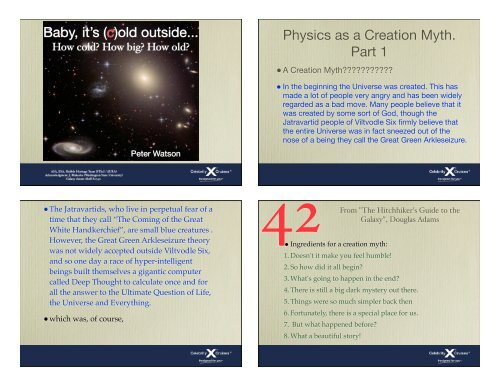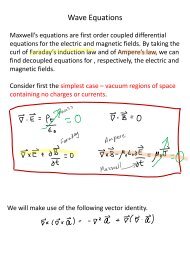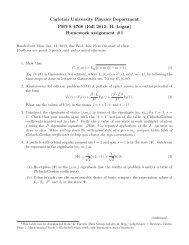Baby, it's (c)old outside... Physics as a Creation Myth. Part 1
Baby, it's (c)old outside... Physics as a Creation Myth. Part 1
Baby, it's (c)old outside... Physics as a Creation Myth. Part 1
You also want an ePaper? Increase the reach of your titles
YUMPU automatically turns print PDFs into web optimized ePapers that Google loves.
<strong>Baby</strong>, it’s (c)<strong>old</strong> <strong>outside</strong>...<br />
How c<strong>old</strong>? How big? How <strong>old</strong>?<br />
ASA, ESA, Hubble Heritage Team (STScI / AURA)<br />
Acknowledgment: J. Blakeslee (W<strong>as</strong>hington State University)<br />
Galaxy cluster Abell S0740.<br />
Peter Watson<br />
•The Jatravartids, who live in perpetual fear of a<br />
time that they call “The Coming of the Great<br />
White Handkerchief”, are small blue creatures .<br />
However, the Great Green Arkleseizure theory<br />
w<strong>as</strong> not widely accepted <strong>outside</strong> Viltvodle Six,<br />
and so one day a race of hyper-intelligent<br />
beings built themselves a gigantic computer<br />
called Deep Thought to calculate once and for<br />
all the answer to the Ultimate Question of Life,<br />
the Universe and Everything.<br />
•which w<strong>as</strong>, of course,<br />
<strong>Physics</strong> <strong>as</strong> a <strong>Creation</strong> <strong>Myth</strong>.<br />
<strong>Part</strong> 1<br />
• A <strong>Creation</strong> <strong>Myth</strong>???????????<br />
• In the beginning the Universe w<strong>as</strong> created. This h<strong>as</strong><br />
made a lot of people very angry and h<strong>as</strong> been widely<br />
regarded <strong>as</strong> a bad move. Many people believe that it<br />
w<strong>as</strong> created by some sort of God, though the<br />
Jatravartid people of Viltvodle Six firmly believe that<br />
the entire Universe w<strong>as</strong> in fact sneezed out of the<br />
nose of a being they call the Great Green Arkleseizure.<br />
42 From<br />
• Ingredients for a creation myth:<br />
1. Doesn't it make you feel humble!<br />
2. So how did it all begin?<br />
3. What's going to happen in the end?<br />
4. There is still a big dark mystery out there.<br />
5. Things were so much simpler back then<br />
6. Fortunately, there is a special place for us.<br />
7. But what happened before?<br />
8. What a beautiful story!<br />
"The Hitchhiker's Guide to the<br />
Galaxy", Dougl<strong>as</strong> Adams
Doesn't it make you feel<br />
humble!<br />
• Space is big. Really big. You won't believe<br />
how v<strong>as</strong>tly, hugely, mind-bogglingly big it is.<br />
Hitchhiker's guide to the Galaxy.<br />
• How big is the universe?<br />
• Could it be infinite?<br />
• Some are tightly wound up,like M31 (the Andromeda galaxy)<br />
• Some are spread out,<br />
like NGC6946<br />
• About 10 billion stars<br />
• About 100,000 light<br />
years across<br />
• Can’t see individual<br />
stars: red patches are<br />
“star nurseries”<br />
• “Hot spot” in centre<br />
•Some are<br />
seen side on<br />
•NGC4565<br />
•Note the<br />
dust clouds<br />
Spiral Galaxies
• Some have “bars” across the centre<br />
•Appears that all<br />
galaxies have a<br />
large black hole<br />
(~ 10,000,000 Mo)<br />
at the centre<br />
•Shows up <strong>as</strong><br />
bright hot spot in<br />
radio & X-rays<br />
The Milky Way is hard to<br />
see, since we are inside it!<br />
• But it looks roughly like<br />
this<br />
• With the sun about here<br />
•Some of them have grabbed h<strong>old</strong> of other galaxies<br />
•This is M51
•Then there are<br />
galaxies that<br />
seem to having<br />
problems:<br />
• NGC 1512<br />
• Starburst galaxy:<br />
stars are forming in<br />
huge numbers<br />
round the <strong>outside</strong><br />
•M87 looks dull<br />
But it’s huge: one trillion stars like the sun<br />
Elliptical galaxies are much<br />
less fun!<br />
Credit: W. A. Baum (U. W<strong>as</strong>hington), WFPC2, HST, NASA<br />
•And it h<strong>as</strong> a huge jet<br />
emerging from the black<br />
hole at its centre<br />
NGC 4881<br />
in Coma<br />
•Which seems more complicated<br />
the closer you look!
Galaxies often come in groups<br />
• 3 galaxies<br />
in Draco<br />
Copyright: Giovanni Benintende<br />
•When galaxies collide the stars almost never<br />
do, but the clouds of g<strong>as</strong> do<br />
•X-ray picture of the antennae<br />
•Which means they can collide<br />
•These are the Antennae galaxies<br />
•And the black holes will eventually coalesce<br />
•(that should be spectacular!)<br />
3C75 X-rays<br />
from Chandra
•M81 and M82 get very close every 100 million years:<br />
Credit & Copyright: Leonardo Orazi<br />
•And the “cartwheel” galaxy is a remnant of<br />
a much <strong>old</strong>er collision<br />
•M 82 is getting ripped apart<br />
•Some are<br />
tightly packed<br />
•Stefan’s<br />
quintet
•As we look out we see more and more<br />
galaxies<br />
•The Coma cluster is made up of 10000 galaxies<br />
•Apart from one bright star, almost all the objects are<br />
galaxies<br />
•But there are more •And the further out we go, the more we see
•So how big is the universe?<br />
•One <strong>as</strong>tronomical unit (AU) is the distance<br />
from the earth to the sun<br />
•150 million km or 8 light minutes<br />
Credit & Copyright: Tom<strong>as</strong> Maruska (SAAD)<br />
•Cepheids are supergiant stars which pulsate<br />
regularly<br />
•Take us out to 20 million parsecs (20 Mpc<br />
which is 100 million lightyears)<br />
NASA, HST, W. Freedman (CIW), R. Kennicutt (U. Arizona), J. Mould (ANU)<br />
•Can use “parallax”<br />
•Type 1a Supernova<br />
•Very rare (1/<br />
galaxy/century)<br />
•Very bright<br />
•And they are all<br />
the same<br />
•This is one in<br />
Centaurus A<br />
•Position of star will<br />
vary over year<br />
•Takes us out to 100<br />
parsecs (400 light<br />
years
•The smallest things we will talk about are galaxies:<br />
•typically 10 billion (10 10 ) stars and a size of 20000 pc<br />
(10 20 m)<br />
20 kpc<br />
• So how big is the universe?<br />
• Could it be infinite?<br />
•NO<br />
Olber’s paradox: why is the<br />
sky dark at night?<br />
• M81 in Ursa<br />
Major: HST<br />
picture<br />
•But most of the time<br />
we'll be talking<br />
about clusters of<br />
galaxies: this is<br />
Virgo.<br />
•Typically 1 million<br />
billion (10 15 ) Mo and<br />
a size of 2 million<br />
parsecs (2 Mpc or<br />
10 22 m)<br />
If you are in the centre of a<br />
forest, what do you see?<br />
• Trees in every direction
If you are in a forest and you<br />
don’t see trees in all<br />
directions, what is going on?<br />
• You are close to the edge<br />
Apparent Ways out<br />
• Obviously universe is not uniform for stars<br />
• But it is for galaxies<br />
•If universe is<br />
1. infinite<br />
2. uniformly filled with<br />
stars<br />
• Any line of sight will end<br />
on a star, <strong>as</strong> bright <strong>as</strong> the<br />
sun.<br />
• so night sky will be bright<br />
Apparent Ways out<br />
Except that<br />
it isn’t<br />
• Light from stars falls off with distance: twice <strong>as</strong> far<br />
means 1/4 the light<br />
• But the number of stars incre<strong>as</strong>es <strong>as</strong> we move out,<br />
so the effects cancel.
Apparent Ways out<br />
• Absorption by interstellar matter dims<br />
distant stars<br />
• But the matter would by now be hot and<br />
radiating<br />
•So we (almost) must have a<br />
universe with a beginning<br />
•Cannot be infinite in both space<br />
and time.<br />
•So can we say when and where the<br />
universe began?<br />
Come back for the sequel!<br />
• Very distant objects<br />
would correspond<br />
to an age of more<br />
than 10 billion (10 10 )<br />
years<br />
• No re<strong>as</strong>on why the<br />
universe should be<br />
the same then<br />
Correct Way Out<br />
•Sources: most pics from<br />
•APOD (Astronomy Picture of the Day)<br />
•NASA<br />
•European Space Observatory<br />
•Notes will be posted at<br />
www.physics.carleton.ca/~watson/





![Assignment 3 [pdf] - Department of Physics - Carleton University](https://img.yumpu.com/19038221/1/190x245/assignment-3-pdf-department-of-physics-carleton-university.jpg?quality=85)

![Assignment 2 [pdf] - Department of Physics - Carleton University](https://img.yumpu.com/19038215/1/190x245/assignment-2-pdf-department-of-physics-carleton-university.jpg?quality=85)




![Assignment 7 [pdf] - Department of Physics - Carleton University](https://img.yumpu.com/19038096/1/190x245/assignment-7-pdf-department-of-physics-carleton-university.jpg?quality=85)

